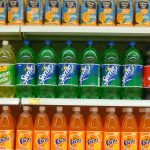Making the healthy choice the cheaper choice
This piece was originally published on BMJ Opinion.
The Soft Drinks Industry Levy (SDIL) is already showing some signs of success. Indeed, a double success—not just lowering the sugar content of drinks, but lowering the comparative prices of no/low sugar products as well. It provides a model for future sugar policies, and indeed nutrition policies in general.
Although changes are still filtering through the distribution system, the three-tier levy, designed to stimulate reformulation of drinks, has achieved its aim. Numerous public statements by the major suppliers (Coca-Cola, PepsiCo, Britvic, AG Barr, Suntory) over the past two years, promising to reduce sugar, are confirmed by products now on the shelves. Only two soft drinks of public health significance remain subject to the highest levy, Classic Coca-Cola and full-sugar (“Blue”) Pepsi. Most other mass market drinks have been reformulated, lowering or eliminating sugar to evade the charge altogether.
The second effect, now also visible in shops, is even more profound. The levy has created a price differential between sugared and sugar free drinks. For example, Waitrose currently sells 500ml bottles of Classic Coke at £1.40, and Diet Coke at £1.25—an 11% difference. With bigger bottles, in varying sizes, the difference in unit prices is 38%. The discounts in other retailers are within that range. The healthy choice has become the cheaper choice.
This has long been the Holy Grail for health economists. Normally, a healthy diet costs more. Those with limited means cannot afford to buy nutritionists’ well-intentioned recommendations. The poor suffer more, in nutrition as well as everything else.
Normally, even healthier variants of standard food products cost more. Companies realise that the main customers for nutritionally improved products are the educated and affluent, willing to pay more for products that they think will do them good.
Exploitive pricing affected soft drinks particularly. The sweeteners commonly used in drinks cost substantially less than sugar. So 2l bottles of sugar free products (diet/max/zero/etc) cost about 10p less to make.
However, everywhere, all over the world, not just in the UK, “parity pricing” prevailed. Sugared and sugar free drinks sold at the same price. Companies added extra margin onto sugar free variants. Manufacturers and retailers shared the additional profit.
SDIL has made a significant breakthrough. Two patterns are already visible in shops, not just theoretical predictions, but changes in the real world.
Simplest is that same-size bottles/cans of sugared and sugar free drinks appear side-by-side in coolers, but with different prices clearly visible on shelf stickers immediately below, thereby encouraging consumers to buy the sugar free options.
More complexly, sugared and sugar free products continue to have the same shelf price—but are sold in different-sized containers. 500ml bottles of sugar free sell for the same price as 375ml bottles of sugared; 330ml cans the same as new 250ml cans. The differential is not so obvious to consumers. Unit prices are usually printed in small type. But the differences in the sizes and shapes of the new bottles and cans are instantly recognisable. There is no doubt which are bigger.
However expressed, these price differentials are a radical change in a popular, mass-market product. With lower prices on sugar free drinks, consumers will now save money making healthier choices. We give people economic incentives, not just moral injunctions.
The UK levy, a graduated extra charge on a problem nutrient, was unique when introduced two years ago. It was intentionally structured to stimulate reformulation. Most other sugary drinks taxes at the time were simply intended to suppress consumption. The UK levy aimed to cut sugar, the others to cut purchases.
SDIL cuts sugar intakes in two ways. Through reformulation alone, people consume less, just buying their normal drinks. We cannot yet measure how much, because sales of reformulated products will not be clear for months.
But that change is likely to be large, strengthened by the second consequence of SDIL, the price differential, which will shift demand towards sugar free.
This two-pronged model can be extended. Already we are discussing levies to other sweet products. Milk based drinks and dairy products are obvious candidates. So are breakfast cereals. The reformulation of cakes and chocolate is technically more difficult in terms of texture and taste, but still possible. Further, the concept could be applied to fat and calorie reduction as well.
But it is not a simple plug-in solution suitable everywhere. With some products, reformulation is technically difficult and substitute ingredients more expensive.
The twin keys to success of a graduated levy on a problem nutrient are that it is applied to products where reformulation is feasible; and it is set at a level high enough to make a visible difference in retail prices, but not so high to depress demand altogether.
Politics matter too. If consumers, who are also voters, object to additional levies, then similar changes in ingredient prices could be achieved, much less visibly, through adjustment to agricultural policies, with lower production quotas and higher basic prices.
In sum, SDIL is already proving to be a success. And its underlying logic can be extended further. It is one model for nutrition policy broadly.
Join us at our next International Breakfast Seminar: The global nutrition crisis – and what food & beverage manufacturers are doing (or not doing) to address it.

